What it is about.
It is about Heidegger’s claim that we “dwell as poets”, a claim justified to the extent that we make our own places … after all the origin of the word poetry is the Greek POEIN which means to make.
The making of places is an action that reveals its POETIC ASPECTS in the building of meaningful spatial relations: instrumental, expressive, esthetic, etc.
Because of this, we do appreciate places above and beyond their instrumental value in as much as they express the identity of their makers and/or the particularities of their spatial conception and environmental ambiance … i.e. to the extent we sense their poetry.
This poetry is often called the genius loci of a place.
*
In a coffee place outdoor terrace situation, as shown in the feature image, this reality can be appreciated in the intricate elements of its territorial definition: its floor texture, chain guard, planter and garden table set, as seen from an inside corner table with its own miniaturized territory: its metal edged ceramic top, set back from the window and with the salt and pepper shakers discretely standing guard.
This reality can also be appreciated experientially as this terrace, having no sunny and shady parts, offers its users complete exposure to the natural elements that can only be modulated by clothing (hat, sunglasses, layered clothing, hat, etc.); it offers also an involvement with the town public space between the buildings, the sidewalk with its passers by and the street with its vehicular circulation.
The fact that no one was seen occupying the terrace must be understood historically as a marketing experiment to answer the needs of bicycling groups who will carry their order to the outside to remain together and near their machines…forming another point of interest for inside users seated along the window!
In a home context, the door between my dining-day room and my living room shown below, together with the one to my kitchen, out of frame to the left, are not only practical for the circuit they provide from the entry way across most rooms, but also “poetically” expressive for the spatial fluidity and lighting modulation that help “make” a dwelling place out of the raw apartment.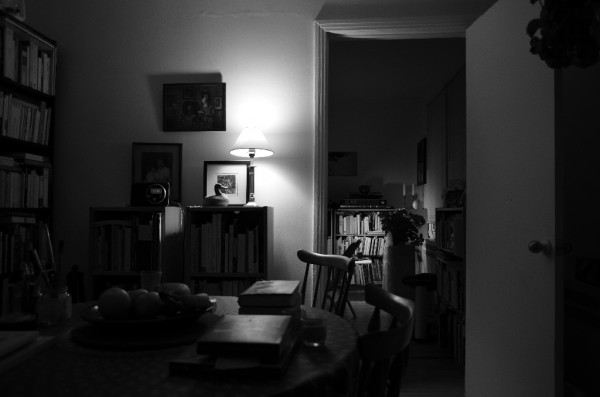
The different activities held in each space, and consequent furnishing layout and lighting pattern, have changed over the last five years and, being at the origin of these changes, have produced in me a sense of identification with this place, a little as a musician begins to identify with an instrument he/she has played for a long time and adapted to his/her way of playing in order to exploit poetically its range of expressivity.
This is what I intend to explore in this PLACE MAKING series, and I can imagine such article title as: PLACE MAKING – The spatial poetics of a: curio shop, pastry counter, public seating, etc.
Conceptual framework
Many writers and academics have explored the nature of the “dwelling as poets” phenomena; I choose to present here two works for their seminal contributions and for possible general interest. (See bibliography.)
We owe to physicist-philosopher G. Bachelard the identification of certain spatial qualities that poetically underpin the making of places, particularly the opposition of circular & center VS. square & corners organization schemes, the gradation of sensory ambiances from the cave to the attic, the dialectic relation between inside and outside, and associations related to size such as miniaturization, etc. all providing a range of experiences and expressive opportunities…hence the title of the work: LA POÉTIQUE DE L’ESPACE.
We owe to behavioral geographer David Seamon the edition of an anthology that, in the words of psychologist Karen Franck, seeks to heal “fundamentally the rifts between us and all that we see as not us”. The title of the work says it all: DWELLING, SEEING AND DESIGNING, because it indicates the will to span the rift between seeing, understanding, producing and using the physical environment: from front porch, to square room, to roof line and massing, to a town sacred structure, to landscape-fauna-flora ecological particularity expressed in formal characteristics, etc.
Place making and the spirit of the Holiday Season
Given the expression Holiday Season is a euphemism for Christmas, minted to invite the participation of the general citizenry in the annual potlatch that this season has turned out to be in the West, what elements of the spatial-environmental support of the Christmas narrative have been adapted to fit the largely lay one of the Holiday Season?
The following elements of that spatial-environmental support have been retained: facing the longest winter night in a coming together across individual circumstances, around man made lights and warmth, with gift exchange centered on the family home and the neighborhood community.
Some elements get more attention than others as shown in the following examples from Sweden and from Montreal.
Examples from Sweden:
In the University town of Lund, at Christmas time, while on sabbatical there, I noticed that the buildings hugging sidewalks had their street facing rooms illuminated with candles, as one urban community across separate individualities, in mutual support to face the long Nordic winter night.
In the commercial city port of Malmö, at Holiday Season, while visiting there I noticed kerosene-burning lights lined up on the edge of sidewalks of main commercial streets, capitalizing on the well-known story of the three kings’ trek carrying gifts!
Examples from Montreal:
Place making and the spirit of the Holiday Season in a commercial setting. In our local large bookstore, as shown below, the Christmas tree “nook” treatment does not seem to embody the spirit of getting together and of gift giving narrative, except in rather anonymous, pre-fabricated manner.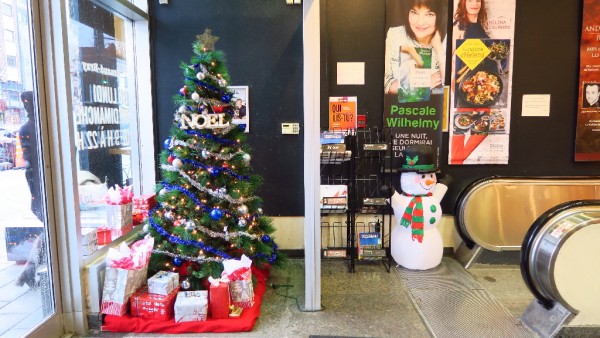
The placing of the Christmas (NOËL) tree, so labeled in large type, in an old glass enclosed telephone nook next to the store double door is an astute decision to lure the passer-by away from the cold into the warm lobby … an astute exploitation of the ease of crossing the tenuous limit between outside and inside yet, placed so close to the entry way, the tree does not encourage stopping to take in the scene and/or getting in the spirit of the Season while shaking off the snow. The entering person must promptly move past the welcoming balloon snowman-doorman to be carried by the escalator to the store proper.
Upstairs, the store floor has been crammed with books in a saturated commercial ambiance, underscored by the fact the few corner armchairs that used to make the bookstore experience a welcoming and homey one were removed; with these gone what do you think is now front and center of the store? Yes, you guessed it … the cash register!
All in all the Christmas tree looked more like a “demonstration” tree, an anonymous advertisement rather than a personal gracious gesture … a counter example of the spirit of the Holiday Season.
Place making and the spirit of the Holiday Season in an institutional setting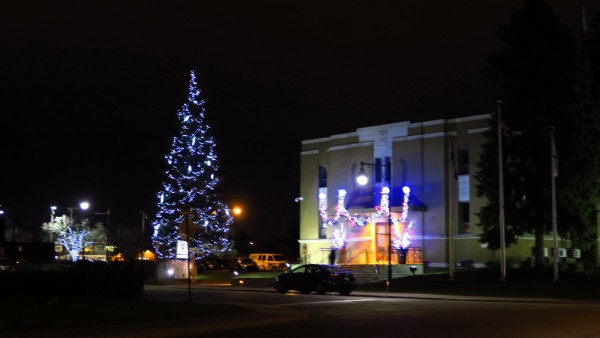
In its most politically and ecologically correct use, i.e. not in a way that would be too religiously explicit to the point of hurting the sensibilities of citizens of other faiths, the Christmas tree in front of Town of Mount Royal City Hall is a full size planted one that gets dressed up in sophisticated light effects while the building entrance is framed with strings of lights, giving it an outdoor temporary movie set … for a birthday scene!
The exterior public space of this town has been carefully neutered, in the lay tradition of a Holiday Season, to be lived as a festival of lights marking the darkest and longest nights of the year with a tall illuminated full size natural fir tree elegantly delineated against the pitch black sky, but without the traditional lit star as political correctitude demands.
Place making and the spirit of the Holiday Season in a residential setting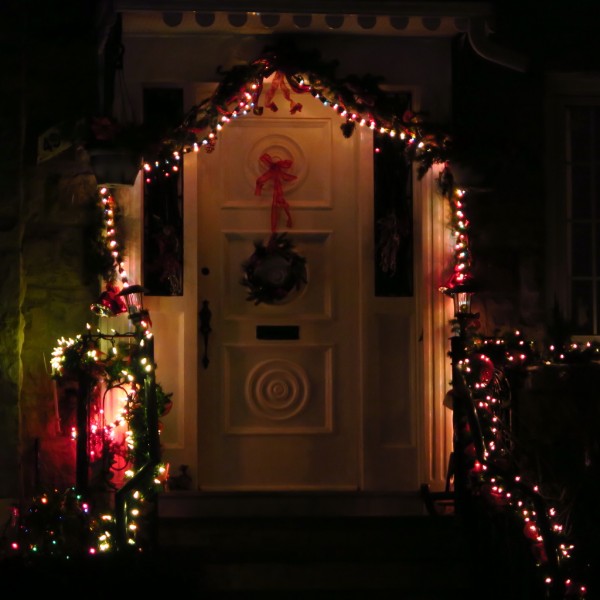
In as much as the decorative showmanship that turns the house into a stage set for angels, Santa and reindeers, turns it also away from the role of the home as cherished family center during the Holiday Season, examples of these extreme practices were not considered here.
After giving it some thought I have come to consider that making arriving and entering guests feel welcomed, would be most in keeping with the lay narrative of the Holiday Season. More precisely, I have asked myself: what exterior decorative treatment would not only satisfy this criterion but would also prefigure a similar treatment once inside?
I found one answer to that question in an old tradition for rural innkeepers to hang tree sprigs over their door as sign of its being open to the arriving guest; I also found that the formal theme of the wreath, as a recognized western ritual symbol of solemnity, was used extensively at many doors in the city to welcome the entering guest.
I can’t think of a more poetic way to make family and friends feel welcomed, than combining these two elements around a house doorway, and hung at its door, as shown in the above photograph.
On one hand the string of lights braided with sprigs, used as a stationary marker, shows welcoming consideration to the guests by guiding them to the point of arrival. On the other hand, the hung wreath swinging inside with the door and becoming one with the act of entering prefigures the same attitude of welcoming consideration toward the guest inside the home.
Discussion: Photography and the poetics of place
Herman Melville has written, in a long lost source: “True places are not found on maps”.
I take it to mean: “The truth of a place cannot be found on a map.”
What Melville is probably saying is that a map, being an abstraction of physical reality from which has been removed all matter of input to the senses, may still be enjoyed for its layout clarity and the useful information it may contain … but the spirit-truth of the places indicated on it cannot be found there, nor experienced in any meaningful way.
Experiencing the truth of place requires therefore a rich array of physical and human input we generally keep in our memory to recount in detail. We can of course make photographs of places to capture something of their spirit, since that medium allows us to document what is seen in ways that ideally express our intuition of what contributes to the poetic quality of a place as experienced…(See image below)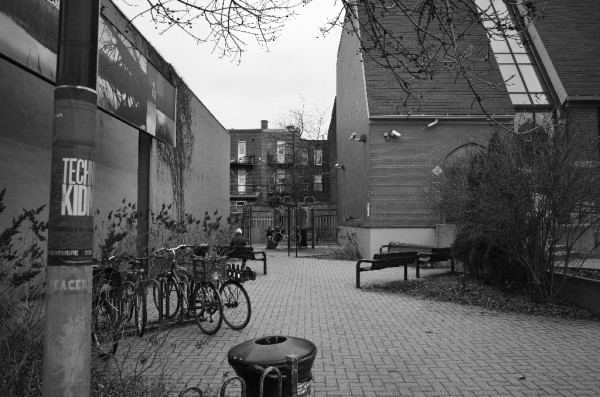
It is in that perspective that the photos included in this series will be made, and presented, along with pertinent comments and analysis, to convey the Genius Loci of the places discussed.
All photos credit Maurice Amiel
Pertinent bibliographical elements:
BACHELARD, G. The Poetics of space (First edition 1957)
SEAMON, D. (Edit.) Dwelling, seeing and designing – Toward a phenomenological ecology (1993)
